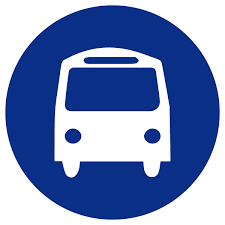 Transit
Transit

Wichita has a limited mass-transit system
(details below),
but has recently made strides towards significant improvements.
Whether those improvements will continue, or be reversed, remains unclear, as Wichita Transit has become a political and budgetary football, with few powerful, effective supporters.
Mass Transit, generally:
Mass transit is generally regarded as the most cost-effective, lowest-polluting form of practical transportation in densely populated urban areas.
However, it is unpopular for several reasons:
Mass transit, by its nature, is not particularly convenient in areas of urban sprawl (such as Wichita), and only reaches a limited range of origins and destinations
(mostly drop-off and pick-up points not immediately adjacent to the riders' intended actual travel origins and destinations).
This requires riders to:
- Travel -- usually by walking -- to a pick-up point;
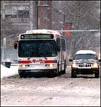
- Wait for up to an hour,
outdoors (in any weather);
and then
- Pay to board the transit vehicle, and
- Ride to a transit drop-off point; and
from there,
- The rider must travel
(usually by walking, again, in any weather)
to their intended destination.
The process is extremely awkward, uncomfortable and time-consuming. And it can be more costly than owning and operating a small, old, used car.
In many cases, even a bicycle -- or even walking -- is more practical than transit. This depends largely upon the quality of the transit system and the geography of the community.
It is also affected by the capabilities of the traveler. Many transit patrons are limited in their physical capacity, possibly so disabled as to be unable to drive -- or restricted from driving for other reasons.
"June 18, 2021, The Range"
on KMUW-FM Radio (Wichita State University)
...includes a segment, at 3 minutes and 50 seconds into the program, interviewing a disabled bus rider about the importance and challenges of riding the bus.
Full audio recording
(which is preceded by a 3:50 segment on Wichita's planned Northwest Bypass)
However, the latest generation of adults -- the "Millenials" -- have shown a greater willingness to use mass transit
than their parents and grandparents. Many of them are more than willing to discard their automobiles (with all their complications and costs), and jump onboard transit buses and trains
-- IF the transit modes are sufficiently...

-
affordable,
-
available,
-
reliable,
and
expedient
...to meet their needs.
This point has been repeatedly made to the City of Wichita by its various consultants advising on city development.
As many millenials gravitate towards urban centers, this becomes increasingly possible. Highly concentrated populations are most easily served by transit (due to short runs with high ridership) -- and less easily served by automobiles, (due to traffic congestion and a shortage of affordable parking space).
And the continued lagging of wages and employment during the recent "jobless Recovery" continued the Great Recession pressure to switch from cars to transit.
The CBS News Overnight & CBS Morning News (May 24-25. 2016) reported that, in 2014, mass transit ridership in the U.S. was the highest it had been in 58 years (since 1956).
(UPDATE 2019: Several years of rising employment, leading to recent growth in wages, have culminated in rising worker fortunes, ending pressure on the consumer for conversion from personal vehicles to mass transit.)
Wichita's Transit System:
Wichita's traditional transit system uses 40-50 large buses, on long cross-city routes, most converging at the city center, with fares around $2/ride. Wichita's regular buses -- largely replaced around 2011 -- have evolved to include wheelchair access and bicycle racks.
A few decades ago, Wichita Transit added about 20 "paratransit vans" (short buses or vans, with wheelchair lifts, for door-to-door service for a limited group of handicapped clients. Fares vary frequently, and may or may not be sponsored or subsidized by other government and non-governmental agencies.
 A handful of small "trolley" buses, providing free rides in the city core, circulate in the downtown and adjacent commercial districts, particularly in the evening hours.
A handful of small "trolley" buses, providing free rides in the city core, circulate in the downtown and adjacent commercial districts, particularly in the evening hours.
 Wichita buses are heated and air-conditioned, but with limited effect, owing to the frequent opening of doors to pick-up and drop-off passengers, poor circulation, large expanses of glass windows (sometimes opened by drivers or passengers), nearly non-existent insulation, and indifferent operation by drivers. Consequently, buses are frequently too hot, or too cold, for comfort. This is somewhat offset by the likelihood that a bus passenger is already dressed for the weather, owing to the need to be out in it for prolonged periods when using transit.
Wichita buses are heated and air-conditioned, but with limited effect, owing to the frequent opening of doors to pick-up and drop-off passengers, poor circulation, large expanses of glass windows (sometimes opened by drivers or passengers), nearly non-existent insulation, and indifferent operation by drivers. Consequently, buses are frequently too hot, or too cold, for comfort. This is somewhat offset by the likelihood that a bus passenger is already dressed for the weather, owing to the need to be out in it for prolonged periods when using transit.
A "Q-Line" shuttle "trolley" -- a trolley-styled small bus -- is operated at low cost throughout much of the downtown area, and
 the adjacent commercial districts east and west (Old Town and Delano, respectively).
(The trolleys are an item of some local pride, as they were built in Wichita by Chance Manufacturing, and adopted by transit systems nationwide.)
the adjacent commercial districts east and west (Old Town and Delano, respectively).
(The trolleys are an item of some local pride, as they were built in Wichita by Chance Manufacturing, and adopted by transit systems nationwide.)
Currently, Wichita Transit is funded by very substantial fares (among the highest in the region -- about $2 for a one-way trip -- providing 14% of system revenue), and by local (33%), state (13%) and federal (38%) subsidies. The city provides some money from its general fund, but grudgingly -- and is constantly "looking for other sources of revenue" to fund a form of transportation that most Wichitans still turn up their noses at. The City continues its lavish subsidies of personal vehicles (massive, expansive roadway development, parking facilities, and public safety services), but remains firmly opposed to anything more than token support of transit.
Most Wichita city planning -- street and infrastructure layouts and land-development oversight -- is handled by the joint City/County Metropolitan Planning Commission (MPC) and their staff (the MP Dept.). But Wichita Transit has little or no representation on the MPC, which traditionally is packed with developer-community cronies of the City Council and County Commission, who appoint the MPC -- people for whom Transit is, at best, a distraction. Transit planning is largely guided by WAMPO -- the transportation-focused Wichita-Area Metropolitian Planning Organization (a local/state/federal body of transportation funding agencies), though real transit plan decisions come from the City Council.
NOTE: For the
Wichita Transit 2017 Annual Agency Profile,
with specific stats and graphs, from the U.S. Dept. of Transportation,
CLICK HERE.
In Wichita, the transit system is substandard, and has been since the late 1960s (a national trend, but particularly conspicuous in Wichita). It has particularly eroded, compared to national norms, during the years since conservatives regained control of the City Commission (later City Council) in the mid/late 1970s. Critics from other cities frequently comment on Wichita as having, in effect, "NO transit system," rather than simply an inadequate one.
A
2019 analysis and review
by Wichita State University professor Chase Billingham reported that:
"According to data from the U.S. Department of Transportation, Wichita Transit received approximately $4.2 million in local funds in 2017. By comparison, [in other comparable cities], [transit] agencies that year received:
- $ 7.4 million in Tulsa,
- $14.1 million in Oklahoma City,
- $14.5 million in Omaha,
- $15.4 million in Des Moines,
and
- $70.4 million in Kansas City.
Local funding covered roughly one-third of Wichita Transit’s expenses in 2017 -- by far the lowest proportion in the region. Meanwhile, Wichita was more reliant on federal grants to fund transit than any nearby city."
~ Assoc. Prof. Chase M. Billingham, WSU,
in
Wichita Eagle, Sept.10, 2019.
The graphs below, from the City's own documents (prepared by University of Kansas researchers) show how Wichita Transit compared in 2010 to the transit systems in Chattanooga, Tennessee (an exceptional case in a milder climate) -- and compared to five of the seven comparable major Midwestern cities nearest to Wichita.
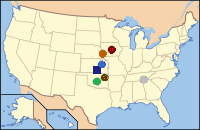
Wichita is the dark blue bar
at far left in every graph. Next to it is
Chattanooga, Tennessee (gray),
followed by
Des Moines (dark red),
Oklahoma City (green),
Omaha (light brown),
Topeka (blue),
and
Tulsa (brown).
(Kansas City and Lincoln, Neb. were omitted.)
(NOTE: To see any of these graphs, enlarged, in a separate window, click on the graph)
|
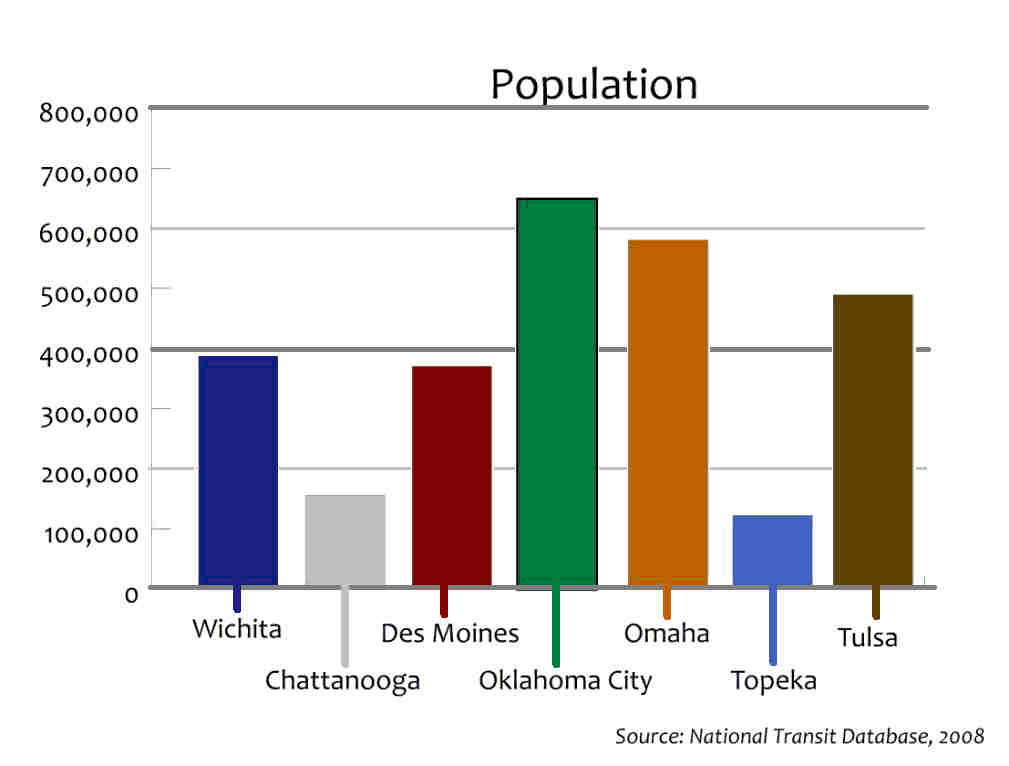
|
"Population" compares Wichita to the other cities by population. Population size does not seem to determine transit performance.
|

|
"Passenger Trips per Capita" compares Wichita to the other cities by the relative frequency with which the public uses transit. Only the towns in Oklahoma fare worse than Wichita.
|
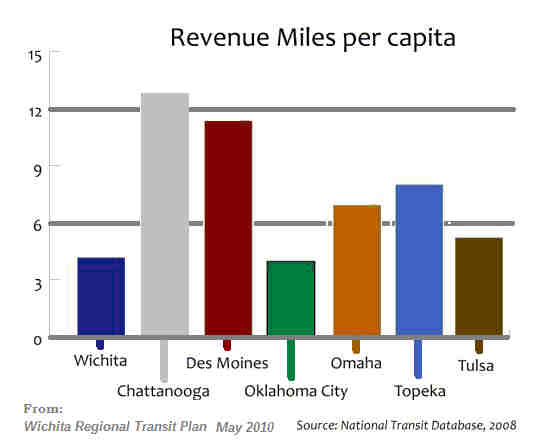
|
"Revenue Miles per Capita" compares Wichita to the other cities by the volume of paid-for service delivered, on average, to each citizen -- a strong indicator of
the transit system's value to the community.
Of the six comparison cities, only Oklahoma City's transit system provides less value to its citizens.
|
Politics & Policy:
Recent pressure from transit advocates and downtown developers -- and strong criticism and warnings from the city's various economic development and downtown-revitalization consultants -- have led to a resurgence of City Council interest in, and support for, mass transit in Wichita.
The Great Recession of 2008-2009 forced many Wichitans into settling for travel by mass transit, some for the first time. And a 2013 study by the Kansas Health Institute found transit issues having a significant impact on the health of many Wichitans.
The cumulative impact of events began to raise the community's interest in a better transit system.
Transit became a conspicuous factor in the 2015 city elections, with the new Mayor (Longwell) elected, in part, by promising strong support for a greatly improved transit system -- in direct opposition to the previous Council's plans to cut service.
In July, 2015, however, Wichita's City Manager Robert Layton proposed a 2016-2017 city budget plan of over $572 million ($16 million more than the previous year) -- but sought to cut transit drastically, down to only about 1% of the city budget, from its already meager 1.5%.
In that proposal, he declared the "need" to cut a quarter of Transit's $8 million budget, down to just $6 million (cutting routes, days, and hours of service, to save $2 million) -- while proposing a city budget with $16 million for parks and recreation, and over $4 million in cultural arts financing.
While his city budget proposal's "performance measures" benchmarks for some other city services evaluated numbers of people served, and the amount of service provided, the budget benchmarks set for Transit were simply cost-control and timeliness benchmarks.
However, facing strong public pressure, echoed by the Mayor and other City Council members, the City Manager grudgingly recanted, penciling back in the $2 million as "stopgap funding" to keep the system intact for another year. But Layton warned that if the city doesn’t find a new source for transit funding in the near future, there will be massive reductions in transit service in 2017.
UPDATE 2017:
The following Wichita Transit financial and statistical data is from the federal government's annual review of federally-funded mass transit systems nationwide.
(The previous regular article continues below the 2017 data & graphs). Click on either image to enlarge in a separate window.
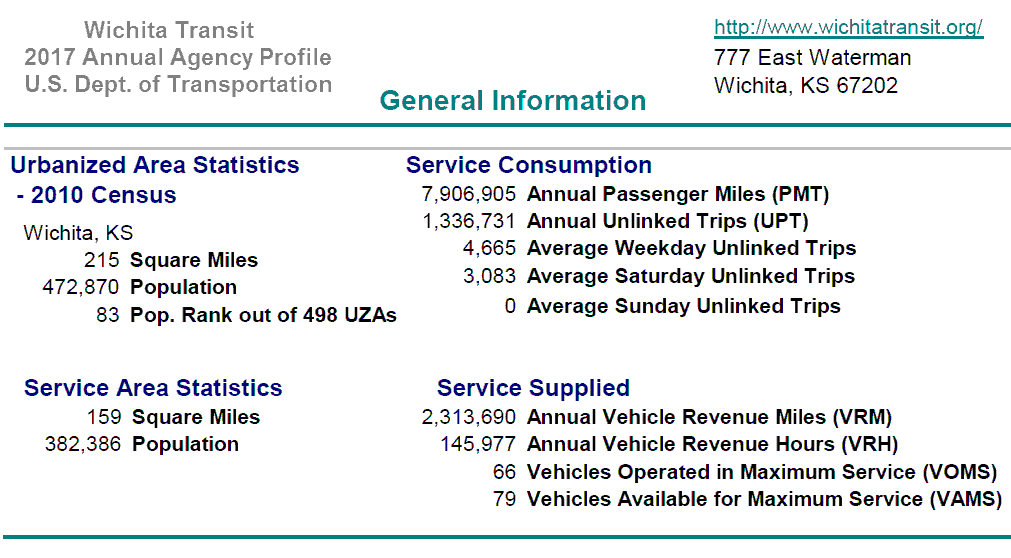

Route Structure Change:

A major characteristic of the Wichita transit system has been its "pulsed hub-and-spoke" system. Bus routes emanate from, and return to, a central (downtown) transit terminal, on a coordinated ("pulsed") schedule, so that all buses arrive and depart together, facilitating immediate transfers. Note the map at right (click to enlarge), showing colored "spoke" routes emanating from the Downtown Transit Center. "Connector loops," shown in black, help tie the system together, as a sort of hybrid between hub-and-spoke system and grid system (see diagram, below, right).
Originally, the Wichita Transit terminal was simply the outdoor area around the Wichita Public Library (then on the 200 block of South Main). Later the City moved it to a dedicated Transit Center, which they erected in the extreme southwest corner of Downtown.
 The hub-and-spoke system was the best mass transit that the city was willing to provide. It connected key employers and shopping centers to poor residential neighborhoods along winding diagonal routes across the city, emanating from -- and returning to -- the downtown Transit Center, where nearly all transfers occurred.
The hub-and-spoke system was the best mass transit that the city was willing to provide. It connected key employers and shopping centers to poor residential neighborhoods along winding diagonal routes across the city, emanating from -- and returning to -- the downtown Transit Center, where nearly all transfers occurred.
Getting On the Grid
As pressure mounted around 2000-2015 for improved transit, critics and consultants urged the City switch from the "pulsed hub-and-spoke" system to a continuous "grid" system, with buses traveling continuously on assigned north-south and east-west major streets. Passenger transfers would be accomplished at intersections around the city -- though without benefit of a Transit Center's indoor accommodations while waiting.
Additional features for younger passengers -- more bike racks, and smartphone apps that help them know where and when to catch a bus -- are expected to increase ridership.
The new grid system should provide faster, more direct transit, and ultimately greater ridership and efficiency.
 However, it will initially require a lot of extra miles and buses, and a prolonged commitment of the city to a two-year moratoriaum on service cuts and route-changes. This is necessary to build trust with prospective and new passengers.
However, it will initially require a lot of extra miles and buses, and a prolonged commitment of the city to a two-year moratoriaum on service cuts and route-changes. This is necessary to build trust with prospective and new passengers.
One of the major undermining factors of transit acceptance in Wichita has been its erratic, squirrelly service -- with various route changes done frequently (often with lilttle advance notice), and with no input from consumers, and little or no regard to the impact on them. The effect has been extremely unnerving to passengers, many of whom give up on the system, as a result -- and resort to other transportation, or stay at home.
(In 2016, the city radically rearranged its route structure, cutting some under-utilized routes, and re-orienting others -- while reducing public access to low-cost fares. Although the City predicted a short drop in ridership, it also predicted a rebound within 18 months. Instead, Wichita Transit lost most of its riders over the period July 2015 to July 2016, and, three years later (in mid-2019), still had not fully rebounded from the abrupt and drastic changes.
Source: Prof. Chase Billingham analysis.)
Many Wichitans have made a real effort to use transit, but found it too untrustworthy. To regain such trust, the system needs to achieve stability and reliability far greater than it has in the past. Anything less than a two-year commitment to a given level of service -- and set of fixed routes -- is inadequate to build the requisite consumer confidence.
The City has never shown that level of commitment to transit, previously, and is unlikely to stay the course with the new grid system. Consequently, it will lose new customers at almost the rate it acquires them, and the future for the system will be nowhere nearly as bright as it could be.
UPDATE 2021: Regression.
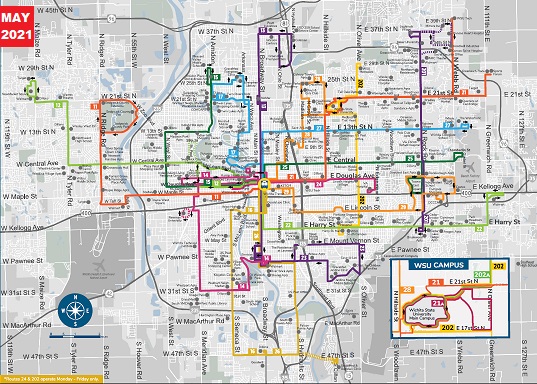
Sure enough, the City has NOT maintained progress migrating the Transit system routes to a grid structure.
Instead, it has done quite the opposite.
By May 2021, the system
regressed almost entirely to the antiquated pulsed-hub system
and
had abandoned even its fringe loops (except for Rock Road),
replacing them with circular endings on routes from downtown.
And, despite a flirtation with increased frequency, the city has largely relapssed on that model as well.
The route structure is now as convoluted as it has ever been
(see map above, click on map to enlarge in a separate tab/window)
-- and a mind-boggling maze for bus patrons to try to commit to memory, let alone the half-syncrhonized schedules. And, of course, route changes remain as frequent, sudden, confusing and user-hostile, as ever.
Contributing factors, of course, were likely:
-
City government's growing focus on downtown
-- including deliberate conversion of downtown into a largely residential area serving the "young professionals" so eagerly sought by the city, in hopes of using them to attract major corporations to the city. (See the "Downtown" section of this website.) The pulsed-hub model focuses bus service on downtown Wichita, where the bus terminal is.
-
The impact of the COVID-19 pandemic of 2020-2021,
which curtailed much economic activity (including fewer people going to work on the bus) -- and created social-distancing and mask-wearing issues for passengers in mass transit -- inevitably reducing bus ridership.
However, if past history is any clue, it is unlikely that the city will, anytime soon, return to the path of route reform that it has abandoned.
Fares remain among the highest in the region,
at $1.75 one-way (and another $1.75 for any transfer).
The only thing close to a cost-effective alternative to the per-ride bus fare is a $5 all-day pass to all routes.
Even in the city's core area -- where most bus patrons are traditionally found -- the system is wildly impractical.
For instance, a trip from the corner of Lincoln and Hydraulic to the grocery at Douglas and Hillside (a 10-minute, 4-mile round-trip by car), is about a 10-mile, 2½-hour round-trip by bus, at best (costing $3.50), with a half-hour layover each way at the bus terminal.
2021-12-15 - Wichita Beacon online
Why has Wichita removed 189 bus stops in 2021?
Wichita Transit dropped 189 bus stops in 2021, up from 49 in 2019. The city says it’s because they’re moving back to a flag stop system. Plans vague. Patron complains of no notice.
Also see:
Transit Center Blunder
The Bus Bench Fiasco
...below,
...AND...
For more on Transit issues, see these articles, linked below, and the additional information on Wichita Transit history, below the links.
Wichita Transit articles:
Transit in Other Communities, and generally:
Special Topics:
 Transit Center Blunder
Transit Center Blunder
The design, development and implementation of the downtown Wichita Transit Center, in the 1980s, is one of the most iconic examples of transit mismanagement -- and public works failure -- in Wichita history.
Designed as the "hub" of the city's "hub-and-spoke" bus system, it was touted as a great advance -- but became something else, altogether.
The city has begun shifting from its traditional hub-and-spoke system to a grid system, as of 2016, reducing the utilization (if not the necessity) for the downtown Transit Center (the "hub" of the hub-and-spoke system).
The City, in the 2010s, announced plans to abandon the Transit Center -- turning it over to Greyhound, the commercial inter-city bus company, for use as Greyhound's new Wichita terminal (replacing the old Greyhound / Continental Trailways terminal on Broadway, between Douglas and Kellogg). (UPDATE, July 2018: At present (summer 2018), Greyhound now has a terminal window inside the northern foyer of the Transit Center, which simultaneously remains in use as the Wichita Transit Center for local bus service.)
Consequently, it may seem irrelevant, now, to dwell on details on the Transit Center and its effect on Wichita Transit. However,
the Wichita Transit Center was a fiasco of such extreme and costly proportions -- an artistic "success," but a functional failure -- that it merits detailed analysis, here, as a warning to future community leaders and developers.
The Transit Center farce is a loud warning about the nature and outcomes of poor city management of transit, based in community officials' complete lack of prolonged, real personal experience with daily transit travel in Wichita, and/or a complete lack of interest in Transit clientele, and insensitivity (or even hostility) toward bus patrons.
Transit Center History & Background
In the 1970s, Wichita buses, using a "hub-and-spoke" system, converged on downtown Wichita along the curving drive in front of the Century II Convention Center, connecting West Douglas Avenue and Main Street. Parking streetside, all at the same time, the buses remained there for 10 minutes, allowing passengers to frantically dash betwen buses, for distances of up to a block, in any weather, to make connections. Passengers waiting for buses (often needed for laggard busses arriving late) were forced to wait outdoors, in all weather, generally unprotected.
The buses and their scurrying passengers created traffic and pedestrian congestion in the heart of the city's main downtown tourist-attraction and leisure-living area (convention center / exhibition & concert halls, hotels, restaurants, library and museums), which annoyed business leaders and city officials. Bus patrons needing to use the bathroom, or wait indoors in foul weather, resorted to "invading" the Library, or surrounding businesses, where they were not generally welcomed.
In the 1980s, to provide shelter from the weather for bus passengers -- and especially to get buses and their low-income passengers away from the City's prize downtown area (the Century II Convention Center, Wichita Public Library, city/county museum, and major hotels, banks, office buildings and Chamber of Commerce headquarters) -- the city selected a site in a delapidated location, in the southeast corner of downtown, well away from any actual bus-patron destinations.
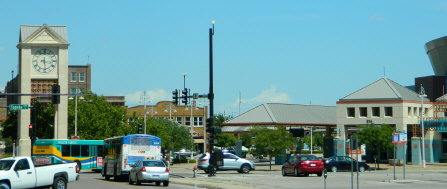 The new Transit Center was very inconveniently located for passengers with downtown destinations, for instance:
The new Transit Center was very inconveniently located for passengers with downtown destinations, for instance:
-
doubling the walking distance to City Hall and the courthouses (from a half-mile, to a full mile)
-- and
-
quadrupling the wallking distance to the Library, Convention Center and primary downtown hotels and restaurants (where some bus patrons work).
(UPDATE 2010s: The new Intrust Bank Arena is a block from the Transit Center, however the Wichita Public Library has been moved much farther away, out of walking distance; it can only be accessed by a single transit route. New residential and commercial development in east Downtown and Old Town is within walking distance of the Transit Center)
Defective Design
The new Downtown Transit Center building and structures proved to be the most poorly designed major public building and facility in modern Wichita history.
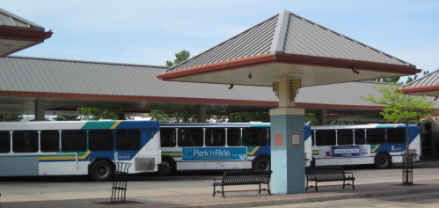 The center was designed more for looks -- superficial aesthetics (largely gratifying the city's aesthetic community, the architects and decorators, and the image-conscious City Commission and their elite friends) -- than for the practical needs of actual bus passengers.
The center was designed more for looks -- superficial aesthetics (largely gratifying the city's aesthetic community, the architects and decorators, and the image-conscious City Commission and their elite friends) -- than for the practical needs of actual bus passengers.
For instance, the ornamental outdoor bus benches were few and far between -- utterly inadequate to seat even a quarter of the bus patrons during a busy period.
 Worse, they were metal (cold in winter, hot in summer), and placed under a gap in the transit walkway roof -- designed for looks (with trees growing through it), rather than function -- ensuring rainfall and snowfall on the benches (and upon anyone sitting on them) in wet weather, and burning sun on benches and on seated patrons in the middle of summer.
Worse, they were metal (cold in winter, hot in summer), and placed under a gap in the transit walkway roof -- designed for looks (with trees growing through it), rather than function -- ensuring rainfall and snowfall on the benches (and upon anyone sitting on them) in wet weather, and burning sun on benches and on seated patrons in the middle of summer.
(In fact, in stormy weather, with wind driving rain or snow even slightly diagonally, the absurd roof gap ensured that EVERYone
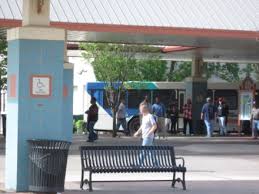 on the transit walkway got wet, regardless of whether they were seated under the roof gap, or were standing under the narrow
roof, or waiting in line, or walking on the "covered" walkway).
on the transit walkway got wet, regardless of whether they were seated under the roof gap, or were standing under the narrow
roof, or waiting in line, or walking on the "covered" walkway).
Indoor seating was plentiful, but here, also, seats were cold metal, poorly designed, and quite uncomfortable. They were stupidly arranged so that most of the patrons had to sit with their backs to the windows -- making it nearly impossible to watch for the bus you needed to catch.
And to use the indoor facility, nearly all passengers had to pass through a single double-doorway, awkwardly positioned, and hampered in its opening and closing by a handicapped-client accommodation that caused the door to open and close slowly. During the chaotic five-to-ten-minute window of bus arrivals and departures, the terminal doorway made it wildly impractical to accomodate all passengers.
Experienced passengers learned to avoid being in the building when buses began arriving -- even though a long transfer delay ensued, with waiting patrons standing in lines on the loading docks, in all weather, for up to a quarter of an hour, before being allowed to board their waiting bus.
 As a grandiose finishing touch to the Transit Center farce, a huge, costly, showy and useless clock tower was erected at the corner of the complex, positioned so it could not normally be seen by many of the patrons, especially if the buses had arrived. It was marked out in awkward-to-decipher Roman numerals, and its face, numbers and hands were in vision-limiting, low-contrast colors. No one ever really uses it for reference, but the city paid a handsome fee to the architect, while city officials crowed about how it enhanced the looks of downtown -- despite being in a section where virtually no one but bus passengers traveled.
As a grandiose finishing touch to the Transit Center farce, a huge, costly, showy and useless clock tower was erected at the corner of the complex, positioned so it could not normally be seen by many of the patrons, especially if the buses had arrived. It was marked out in awkward-to-decipher Roman numerals, and its face, numbers and hands were in vision-limiting, low-contrast colors. No one ever really uses it for reference, but the city paid a handsome fee to the architect, while city officials crowed about how it enhanced the looks of downtown -- despite being in a section where virtually no one but bus passengers traveled.
(UPDATE Spring 2023:None of the clocks on the four sides of the clock tower show correct time -- and, in fact, they all show wildly different times, sometimes hours apart. Likewise, the similar indoor ornamental clock, in front of the customer service window, is malfunctioning. Mentioning it to one staffer got the dismissive reply from her: "Yeah, I know." Another staffer in the customer service booth, a man, resented the suggestion that he mention the malfunctioning clocks to management "like I don't have more important things to do.")
Some notable advantages were provided by the Transit Center, however, including a dollar-bill change machine (and change available, sometimes, from an unreliable counter attendant), vending machines (allowing a quick snack during a long commute), and -- most importantly -- bathrooms (though poorly maintained, they were effective enough for the need).
A large route map on the waiting-room wall provided useful guidance, and individual pocket route-maps and schedules were distributed in racks. Sometimes -- but on no reliable schedule -- a clerk or bus manager could be found to answer questions or provide assistance with a patron's problem (if the Transit official was in a mood to be helpful, which some occasionally were).
But, on balance, the costly Transit Center was a miserable failure, adding almost as much to bus patron misery as it helped. Despite wild predictions that it would radically improve things for bus passengers, and attract more riders, the popularity of the Wichita bus system apparently never improved as a consequence.
The Bus Bench Fiasco
Another farce in transit management in Wichita was the elimination of the long-standing traditional concrete-framed, wooden-seated/wooden-backed bus benches, scattered at common bus-boarding points around the city. Though hardly luxurious, and (on rare occasions) capable of supplying splinters, the simple wooden-planked seats were hardly ever too hot or too cold for sitting on, in any weather. And their large wooden backs made for easy adaptation as advertising billboards, bringing the bus system some extra revenue.
Starting in the 1980s, however, the City decided it would switch to elegant, black, wrought-iron benches -- without considering the impact on the people who would need to use them.
 The result: Bus benches that get so hot in summer, so cold in winter, that people commonly stand, rather than sit on them, while waiting (often up to an hour) for a bus, in the tiring extreme temperatures that characterize Wichita.
The result: Bus benches that get so hot in summer, so cold in winter, that people commonly stand, rather than sit on them, while waiting (often up to an hour) for a bus, in the tiring extreme temperatures that characterize Wichita.
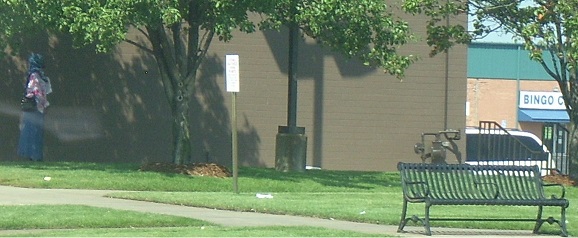 On a summer's day, while waiting for her bus, a purple-attired woman from Sudan (one of the hottest places on Earth), stands in the shade, at far left, for over half an hour, rather than sit on the sun-baked black metal bus bench, at far right.
On a summer's day, while waiting for her bus, a purple-attired woman from Sudan (one of the hottest places on Earth), stands in the shade, at far left, for over half an hour, rather than sit on the sun-baked black metal bus bench, at far right.
Further, a peculiarity of their design makes them prone to catch and retain snow, ice and rain -- often making them unusable for hours (even days) after a storm has passed.
And, while elegant to look at (for the more-fortunate automobile drivers whizzing by in their comfortable cars), the metal benches lacked the high billboard-sign backs that had shielded passengers from wind, and provided desperately needed revenue for the bus system (while paying for maintenance of the original bus benches).
Again, this was preventable, had the City Council, City Manager, city planners and architects, and even the Transit Director, had substantial recent experience as daily bus passengers themselves, across all of Wichita's seasons.
However, the perpetual snobbish, reckless, stubborn or lazy refusal of city officials -- and other "leaders" -- to spend substantial time getting personally, physically familiar with local transit travel, has resulted in spectacularly gross incompetence in their management of Transit, resulting in an ever-continuing string of failed policies and costly, destructive "solutions" that eliminate, rather than optimize, opportunities for improvement.
Hence, the common remark of visitors from other cities, that "Wichita has NO transit system."
Participate - Let your voice be heard!